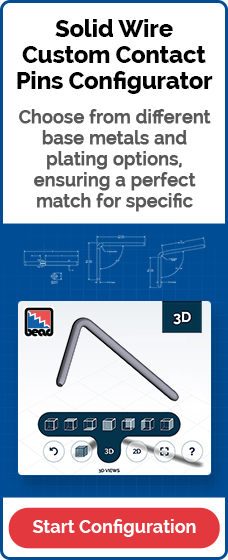Contact plating is essential for manufacturing electronic components. It improves performance, utility, and durability. Proper plating helps ensure a device will perform reliably.

Plating improves corrosion resistance and electrical conductivity. It also enhances solderability and protects the metal conductor from wear.
But which material should you use for plating your connector pins and electrical contacts? In a time of price spikes and metals shortages, knowing your options is critical.
Learn more about the metals you can use for plating electronic connector pins and contacts. From there, you can find the right material for your application.
Noble Metals
Many plating options are available for connector pins and electrical contacts. Noble metals are desirable because they lack chemical reactivity and resist oxidation and corrosion.
GOLD
Gold is one of the most popular choices for electric plating. It's very conductive even at low voltages. Gold is highly resistant to oxidation and corrosion compared to other metal plating options.
Gold is ideal for applications in environments with high humidity or frequent thermal cycling. It does well as plating for flexible connections and springs. Gold is good for medical equipment like MRI scanners because it's non-magnetic.
The main disadvantage of gold is the price. Gold is expensive compared to other options.
Typical plating thickness: 10-50 u"
Common Applications:
|
SILVER
Silver is another highly conductive plating option. It has good corrosion resistance. Silver is less expensive than gold.
Silver performs well in applications that require a high power transfer of electricity. It's a good choice for larger components because of its lower cost. Silver is a metallic lubricant, so it's ideal for threaded or sliding contacts.
The main disadvantage of silver plating is that it forms compounds like silver sulfide that reduce conductivity.
Typical plating thickness: 100-300 u”
Common Applications:
|
PALLADIUM
Palladium is a noble metal. It's highly resistant to corrosion.
Palladium has very high electrical and thermal conductivity. It's harder than gold or silver. This hardness makes it a good choice for applications that need more resistance to wear and tear.
Its low surface contact resistance makes palladium well-suited for plating connectors and contacts.
Typical plating thickness: 10-30 u”
Common Applications:
|
RHODIUM
Rhodium is a final example of noble metal plating. Harder than palladium, Rhodium has high electrical conductivity and is very resistant to corrosion.
Rhodium is resistant to acids. It's well-suited for applications that need good wear resistance and high hardness.
Typical plating thickness: 20 u”
Common Applications:
|
Passive Metals
Passive metals are non-noble metals that have high corrosion resistance. An oxidation layer creates a film on the metal's surface that prevents further corrosion.
TIN
Tin provides some corrosion resistance. It's non-toxic in lead-free formations, which can be an advantage for medical applications. Only some older military programs may still specify tin with lead.
Tin has low contact resistance and good solderability. It's a low-cost choice.
Tin is best for applications with a relatively low number of mating cycles. It performs well under dry circuits and low-level conditions. However, it's not well-suited for continuous service at high temperatures.
Typical plating thickness: 100-300 u”
Common Applications:
|
NICKEL
Nickel is very hard and durable with great resistance to corrosion. It withstands wear and tear and reduces friction.
Nickel also has high electrical conductivity.
Nickel is ideal for high-use components because of its durability. It's an economical choice for corrosion resistance.
Typical plating thickness: Flash - 300 u”
Common Applications:
|
Other Types of Metal
Other plating metals are available. They will corrode; however, a protective layer of another metal can limit corrosion.
These metals are often an economical option.
COPPER
Copper has one of the highest rates of electrical conductivity. It's a cost-effective solution. However, it needs a protective layer to prevent corrosion.
Copper is often an underplate for subsequent metal plating. Copper has excellent adhesion properties and can be used between layers of plating to enhance adhesion. Copper performs best in dry environments with relatively stable conditions.
Typical plating thickness: flash – 200 u”
Common Applications:
|
|
|
Metal Alloys
Metal alloys are another choice. Alloys combine a metal with other metals or non-metallic materials.
WHITE BRONZE
White bronze is an alloy of copper, tin, and zinc. In addition to being non-magnetic and non-allergenic, White Bronze is also more conductive than nickel.
White bronze has good resistance to wear, corrosion, and tarnishing.
It's a good choice for medical applications and well-suited for RF connectors. White Bronze performs well in environments with rapid temperature changes.
Typical plating thickness: 50-200 u”
Common Applications:
|
|
|
PALLADIUM NICKEL
Palladium nickel originated as a lower-cost alternative for gold. The alloy has very good corrosion resistance, low contact resistance, and good solderability. It resists heat and stress.
Palladium nickel plating is usually flashed with gold. This gives it lubricating properties and better corrosion resistance.
Palladium nickel can withstand a high number of mating cycles. It's well-suited for applications that require durability with a lower weight and performs well in high-heat environments.
Typical plating thickness: 10-30 u”
Common Applications:
|
ELECTROLESS NICKEL
Electroless nickel plating is versatile in that it can be applied to conductive and non-conductive surfaces. This nickel alloy coating is deposited by chemical reduction, meaning without electrical current as with nickel electroplating.
Most electroless nickel deposits are alloyed with phosphorus in the range of 2-14%. The higher the phosphorus content, the greater the corrosion resistance, but the hardness also decreases.
Compared to electrolytic nickel, electroless provides a more uniform thickness over the substrate - even in holes and IDs. It is also less prone to porosity.
Typical plating thickness: 50–300 u”
Common Applications:
|
|
|
NICKEL PHOSPHOROUS
Nickel phosphorus alloys have high wear and corrosion resistance. They have good solderability and provide some lubrication. Nickel phosphorus creates a uniform layer at many different thicknesses.
Nickel phosphorus alloys are used for electroless plating. This process is an alternative to electroplating. It deposits the alloy using a chemical process instead of an electrical current.
Nickel phosphorus is a good choice for parts that are difficult to coat. It performs well in corrosive environments and can handle high-use applications.
Typical plating thickness: 1–40 u”
Common Applications:
|
|
|
Choosing the Right Contact Plating for Your Connector Pins
You have many plating options for electrical connector pins and contacts. The best material choice is dependent on your project specifications and your budget.
The specialists at Bead Electronics can help you find the right solution for your electronic connector pins for signal or power applications. We manufacture custom pins and contacts made from wire for end-to-end pins for automatic insertion or in loose piece form. Bead also offers lightweight and robust hollow pins made from flat stock. We'll help you design the perfect connector pins for your application.
Contact us today to discuss your project. We look forward to working with you! 



